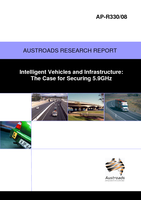Traffic Management

Intelligent Vehicles and Infrastructure: The case for securing 5.9 GHz
- Publication no: AP-R330-08
- ISBN: 978-1-921329-71-5
- Published: 10 July 2008
- PDF (free) Download
This report presents the case for a secure frequency band of 5.850 to 5.925 GHz (referred to as 5.9 ITS ) for cooperative intelligent road transport systems that provides critical road safety and traffic efficiency outcomes. The report is the final summary report for the Austroads Council and it recommends that in the interim an embargo be placed on the band while a suitable entity is formed to represent the road transport industry. Australia s relatively small market dictates that the international harmonisation of the technology, standards, and devices is of prime importance. Achieving this will require that Australia adopts at an early stage the same radio spectrum arrangements that are currently in the process of being applied in Europe and America. The national radio communications spectrum regulator, The Australian Communications and Media Authority, is aware of the emerging requirement and has already performed some preliminary research resulting in a draft policy paper outlining a proposed plan for allocating the 5.9 ITS spectrum. This paper is informative on the spectrum management issues, and is also supportive of the requirements of the Australian transport industry to the extent that ACMA currently understands them.
- AP-R330-08 Intelligent Vehicles and Infrastructure: The Case for Securing 5.9 GHz
- CONTENTS
- 1. INTRODUCTION
- 2. TRANSPORT CHALLENGES
- 2.1. Safety
- 2.2. Congestion
- 2.3. Environment
- 3. INTERNATIONAL DEVELOPMENTS
- 3.1. North American developments
- 3.2. European developments
- 3.3. Asian developments
- 3.4. Australian Developments
- Safety
- Mobility
- . Deployment
- 5.1. Allocation of 5.9GHz spectrum
- 5.2. Institutional issues
- 5.3. Technical issues
- 4. PROPOSAL FOR AUSTRALIA
- 4.1. Benefits and costs
- 5. DEPLOYMENT
- 6. CONCLUSION AND RECOMMENDATIONS
Related publications
AP-R535-16
Latest Traffic Management News
